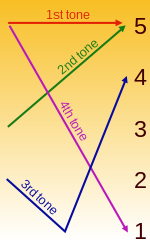lingvo.wikisort.org - Language
Shenyang Mandarin (Chinese: 沈阳话) is a dialect of Northeastern Mandarin used by people in and around Shenyang, the capital of Liaoning province and the largest city in Northeast China. It is very close to Standard Chinese but has some notably distinctive words. Some people consider it a strong accent rather than a distinct dialect. Because of its similarity to the standard language, pinyin can be used to represent its pronunciation. Its usage is dwindling as schools in Shenyang teach only the standard language.

This article needs additional citations for verification. (November 2006) |
| Shenyang dialect | |
|---|---|
| 瀋陽話 / 沈阳话 Shěnyánghuà | |
| Native to | China |
| Region | Shenyang |
Language family | Sino-Tibetan
|
| Language codes | |
| ISO 639-3 | – |
Linguist List | cmn-she |
| Glottolog | shen1252 |
The most distinctive aspect of the Shenyang dialect is the much lower pitch of the first tone than in Standard Mandarin. It would be positioned at 2, rather than 5, on the chart shown (right). As a result, it can sound rather like the third tone.
Like the Beijing dialect, the Shenyang dialect is characterized by erhua (儿化).
Some of the words in the Shenyang dialect come from other languages like the Manchu language. One example is 旮旯儿 gālár 'corner'.
Examples of words in various Northeastern dialects (not necessarily specific to Shenyang) include:
| Northeastern Mandarin | pinyin | Standard Mandarin | pinyin | Translation |
|---|---|---|---|---|
| 不赶趟儿 | bù gǎntàngr | 来不及 | lái bù jí | too late |
| 波楞盖儿 | bōlingàr | 膝盖 | xīgài | kneecap |
| 疙瘩、圪塔[citation needed] | gāda | 地方 | dìfang | place (noun) |
| 得瑟 | dèse | 卖弄 | màinòng | to show off |
| 老鼻子(了) | lǎobízi(le) | 很多 | hěnduō | a lot |
| 驲驲地 | rírídi | (象声词:车速度快) | N/A | onomatopoeia: fast car |
| 埋汰 | máitai | 脏 | zāng | dirty, filthy |
| 嘎哈 | gàhá | 干什么 、干嘛 | gànshénme, gànmá | What are you doing? |
| 砢碜 | kēchen, kēzhen | 丑、难看 | chǒu, nánkàn | ugly, hideous |
| 老 | lǎo | 很 | hěn | very |
| 贼 | zéi | 特别 | tèbié | exceedingly |
| 毙 | bì | 棒 | bàng | good, excellent |
| 蚂蛉 | māling | 蜻蜓 | qīngtíng | dragonfly |
| 嘎赌 | gàdu | 打赌 | dǎdǔ | to bet |
Phonology
Shenyang dialect has 19 initial consonants, as opposed to the 21 in Standard Mandarin. Notably, the retroflex consonants [ʈ͡ʂ], [ʈ͡ʂʰ] and [ʂ] in Standard Mandarin are pronounced as [t͡s], [t͡sʰ] and [s], respectively, while [ɻ] is omitted. While lost in Standard Mandarin, Middle Chinese [ɳ] is preserved in the Shenyang dialect. [v] also exists in the Shenyang dialect.[1]
| Labial | Alveolar | Dental sibilants | Palatal | Velar | ||
|---|---|---|---|---|---|---|
| Stops | unaspirated | p | t | t͡s | t͡ɕ | k |
| aspirated | pʰ | tʰ | t͡sʰ | t͡ɕʰ | kʰ | |
| Nasals | m | n | ɳ | |||
| Fricatives | f | v | s | ɕ | x | |
| Approximants | l | |||||
Standard Mandarin diphthongs tend to be pronounced as monophthongs in the Shenyang dialect. For example, [ai] becomes [æ], and [au] becomes [ɔ].[1]
References
- Meng, Xiangyu 孟祥宇 (2011). "Shěnyáng fāngyán yīn xì gàishuō" 沈阳方言音系概说. Yǔwén xuékān 语文学刊. 2011 (2): 31–33.
На других языках
- [en] Shenyang Mandarin
[ru] Шэньянский диалект
Шэньянский диалект (кит. трад. 瀋陽話, упр. 沈阳话)) - это диалект северо-восточного мандаринского языка, на котором говорят в Шэньяне и его окрестностях, столице провинции Ляонин и крупнейшем городе на северо-востоке Китая. Он схож со стандартным китайским языком, но имеет характерные только для данного диалекта слова. Некоторые считают его лишь ярко выраженным акцентом, а не обособленным диалектом. Из-за своего сходства со стандартным китайским языком, пиньинь может отражать верное произношение.Другой контент может иметь иную лицензию. Перед использованием материалов сайта WikiSort.org внимательно изучите правила лицензирования конкретных элементов наполнения сайта.
WikiSort.org - проект по пересортировке и дополнению контента Википедии
